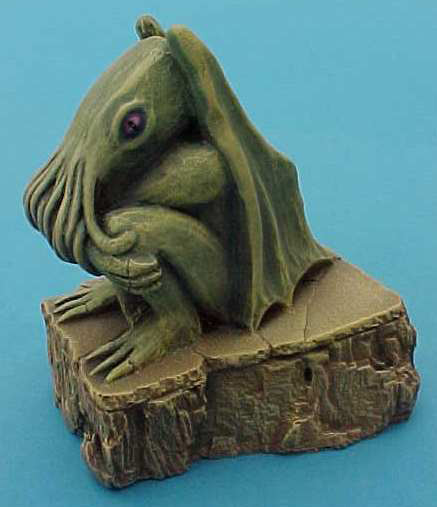View current page
...more recent posts

Calling Cthulhu by Erik Davis:
For [H.P.] Lovecraft, scientific materialism is the ultimate Faustian bargain, not because it hands us Promethean technology (a man for the eighteenth century, Lovecraft had no interest in gadgetry), but because it leads us beyond the horizon of what our minds can withstand. "The most merciful thing in the world, I think, is the inability of the mind to correlate all its contents," goes the famous opening line of "Call of Cthulhu." By correlating those contexts, empiricism opens up "terrifying vistas of reality"—what Lovecraft elsewhere calls "the blind cosmos [that] grinds aimlessly on from nothing to something and from something back to nothing again, neither heeding nor knowing the wishes or existence of the minds that flicker for a second now and then in the darkness."Davis's essay considers the before-and-after role of religion in HPL's prose: elements of magic and ritual appropriated by the author for his world of materialistic horror as well as attempts by various cults and Internet wackos to claim the Necronomicon as an authentic text. The in-depth research illuminates but possibly ameliorates Lovecraft. Davis's emphasis on the "Outside Within," a domain of eldritch visions that can be instructive as well as devastating to the religious seeker, breaks the spell that HPL is indeed describing malevolent conspiracies beyond the control of our Enlightened societies and diminishes his central insight: that these forces are real. (Cue organ.) I prefer the political dimension that some writers have claimed for the Providence recluse, such as Robert Bloch's litany of "modern horrors" not generally cognizable at the time Lovecraft wrote his stories but making him only too relevant to current readers: serial killers operating in the cracks of civilization, technologically assisted genocide, horrors beyond our capacity to absorb horror--to which one might add the televised mass chaos post-Katrina and the drill-killing insanity in Iraq unleashed by Dick Cheney, the ultimate Lovecraftian leader.
Lovecraft gave this existentialist dread an imaginative voice, what he called "cosmic alienage." For Fritz Leiber, the "monstrous nuclear chaos" of Azathoth, Lovecraft's supreme entity, symbolizes "the purposeless, mindless, yet all-powerful universe of materialistic belief." But this symbolism isn't the whole story, for, as DMT voyagers know, hyperspace is haunted. The entities that erupt from Lovecraft's inhuman realms seem to suggest that in a blind mechanistic cosmos, the most alien thing is sentience itself. Peering outward through the cracks of domesticated "human" consciousness, a compassionless materialist like Lovecraft could only react with horror, for reason must cower before the most raw and atavistic dream-dragons of the psyche.
Modern humans usually suppress, ignore or constrain these forces lurking in our lizard brain. Mythically, these forces take the form of demons imprisoned under the angelic yokes of altruism, morality, and intellect. Yet if one does not believe in any ultimate universal purpose, then these primal forces are the most attuned with the cosmos precisely because they are amoral and inhuman. In "The Dunwich Horror," Henry Wheeler overhears a monstrous moan from a diabolical rite and asks "from what unplumbed gulfs of extra-cosmic consciousness or obscure, long-latent heredity, were those half-articular thunder-croakings drawn?" The Outside is within.
[Thanks to Davis for the shout to this blog a while back--I'm disagreeing with him a bit here but his nod made my week--Techgnosis is awesome.]
Photo: Cthulhu (and other carvings against uniformly blue backgrounds) from Monolith Design. "Monolith Design was founded in 1990 by Stephen Mussared and is committed to producing carefully researched, well-made gaming miniatures for a wide variety of scales and periods, from Ancient Egyptian through Twentieth Century to Science Fiction and Fantasy. The models are cast in high quality resin [...]" [via travis about two years ago]
